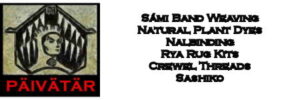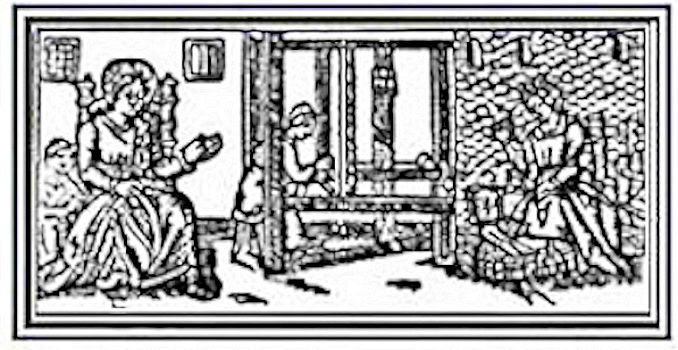Further to my last article about the Guild of Canadian Weavers, dateline 07/01/98, this is a brief overview of the Guild’s Test Requirements for obtaining the Master Weaver certification. A major focus of the GCW is “to prepare and set examinations at designated periods for the benefit of those wishing to qualify for the 4 stages of regular membership in the guild.”
The tests are divided into 4 sections. Each level must be completed successfully, before proceeding to the following level. Completed projects are submitted for marking twice per year, in April and September to the Test Administrator. The tests are then sent to judges located in another province, to maintain confidentiality and fairness in marking.
A brief summary of the projects follows. Full details of the test program are included in your information package upon joining the Guild.
Level 1 – Basic
1. Twill gamp sampler
2. Overshot, as-draw-in sampler.
3. Overshot borders sampler.
4. Colour gamp using 2/8 cotton.
5. M’s and O’s project using wool.
6. Summer-and-winter 2 block sampler.
7. Crackle weave sampler.
8. Wool yardage suitable for clothing.
9. Notes describing a warping system.
10.a) A brief report on 5 publications about handweaving.
10.b) Discuss some weaving problem which has puzzled you and how you solved it.
Level 2 – Intermediate
11.a) Written description of differences between Bronson and Swedish Lace.
Drawdown to illustrate all possible combinations of lace and plain weave in both weaves.
11.b) 2 hand hemmed small tray cloths, one in Bronson lace and one in Swedish Lace.
12. Huck weave sampler.
13. Finger manipulated weaves using 2/8 cotton.
13.a) Sampler using embroidery techniques: Dukagang, Half-dukagang, Laid-in-the-shed, Italian Laid-in, Soumak.
13.b) Sampler showing lace techniques: Mexican twist, Greek lace, or other leno weave, Brook’s bouquet, Spanish lace, Danish Medallion.
14. Double Weave Pick-up sample suitable for a wall hanging.
15. Warp faced sample.
16. Weft faced sample.
17. Texture sample suitable for drapery or upholstery.
18.a) Card weaving sample.
18.b) Ceinture Flechee or other hand-controlled plaiting technique.
18.c) Weft twining.
19.a) Plaid
19.b) Plain weave.
19.c) 2/2 twill
20. Sample analysis and identification of 4 samples of handwoven materials.
Level 3 – Senior
21. Weaver controlled rug techniques, consisting of 4 samples: Flossa, Half-flossa, Rya, Rolakan, Soumak or suitable tapestry technique including a different finish for the warp ends on each sample.
22.a) Original Overshot with borders.
22.b) Original Overshot woven as:
1) As-drawn-in
2) Rose fashion
3) On opposites
4) Italian fashion
5) Honeycomb
23.a) Explain the function of the profile draft and how it can be used in changing a design. Explain the relationship between units and blocks.
23.b) Design a 4 block profile draft and develop it in 3 different profile drawdowns.
23.c) Choose 1 of the above designs and give thread-by-thread threading, tie-up and treadling drafts.
24.a) Design a 2 Block pattern.
24.b) Weave 3 eight shaft samples using the above profile:
1) False Damask
2) Double-faced twill
3) Double weave
25.a) Design a 6 block profile draft, suitable for weaving in summer-and-winter technique.
25.b) Using same profile draft, make profile drawdown suitable for weaving in Bronson lace.
25.c) Weave sample of either a or b above.
26. Multi-shaft twill sample gamp showing 4 or more 8 shaft or 12 shaft twill threadings.
27. Design and weave a wall hanging.
28. Loom-controlled sample using supplementary-warp patterning.
29.a) Describe principles of colour-and-weave effects from 2 shaft to multi-shaft weaving.
29.b) Explain principles of shadow weave.
29.c) Weave a sample showing either a or b above.
30. Sample identification.
Level 4 – Master
31. Tapestry sample.
32.a) Tie-up drafts for 5, 6, 7, 8 and 10 shaft Satin weave.
32.b) Design 2, 3 and 4 block patterns for a 5 shaft satin.
32.c) Weave a sample of 8 shaft satin or 1 of designs above.
33.a) Design profile draft for 12 shaft summer-and-winter weave.
33.b) Design profile draft for 16 shaft Bronson lace weave.
33.c) Design an 8,12, or 16 shaft Huck lace.
33.d) Weave sample of one of the Huck lace designs above in c.
34. Sample identification.
35. Monograph
35.a) Choose a subject for in-depth study. May be a specific weave (2 shaft, twills, overshot, summer-and-winter, lace weaves) or subject matter (clothing weaves, linen, upholstery, rugs) or a field (teaching, publications, curative measures, commercial)
35.b) Present chosen subject in an essay covering a reasonably complete historical background, present use etc. including summary of research references.
35.c) Accompany essay with a comprehensive group of woven articles or samples.
Update:
The Guild of Canadian Weavers now has a website. The GCW tests have been revised. The latest GCW Test Requirements can be downloaded in .pdf format.
Hand Weaving Books
Weaving on a Little Loom (Everything you need to know to get started with weaving, includes 5 simple projects
The Key to Weaving: A Textbook of Hand Weaving for the Beginning Weaver
The Weaver’s Companion (The Companion Series)
Learning to Weave
The Big Book of Weaving: Handweaving in the Swedish Tradition: Techniques, Patterns, Designs and Materials
The Handweaver’s Pattern Directory
A Weaver’s Book of 8-Shaft Patterns: From the Friends of Handwoven
Krokbragd: How to Design & Weave
Doubleweave: On Four to Eight Shafts
Double Weave: Theory and Practice<
Magic of Doubleweave: The Best of Weaver’s (Best of Weaver’s series)
Weaving In the Arts: Widening the Learning Circle
DIY Woven Art: Inspiration and Instruction for Handmade Wall Hangings, Rugs, Pillows and More!
>On the Loom: A Modern Weaver’s Guide
 LONGTHREAD MEDIA VIDEO
LONGTHREAD MEDIA VIDEO
 LONGTHREAD MEDIA SUBSCRIPTIONS
HANDWOVEN MAGAZINE
PIECEWORK MAGAZINE
SPINOFF MAGAZINE
LEARN LONGTHREAD MEDIA
PAIVATAR HANDMADE
LONGTHREAD MEDIA SUBSCRIPTIONS
HANDWOVEN MAGAZINE
PIECEWORK MAGAZINE
SPINOFF MAGAZINE
LEARN LONGTHREAD MEDIA
PAIVATAR HANDMADE
 Paivatar on YouTube
Visit my YouTube channel for how-to craft videos.
Paivatar on YouTube
Visit my YouTube channel for how-to craft videos.
Or Please visit my Channel on Rumble for more how-to videos.
https://rumble.com/Paivatar
LIVE STREAMS - Paivatar Studio
KICK
TWITCH MAKERS&CRAFTING
YOUTUBE
Categories: HAND WEAVING



